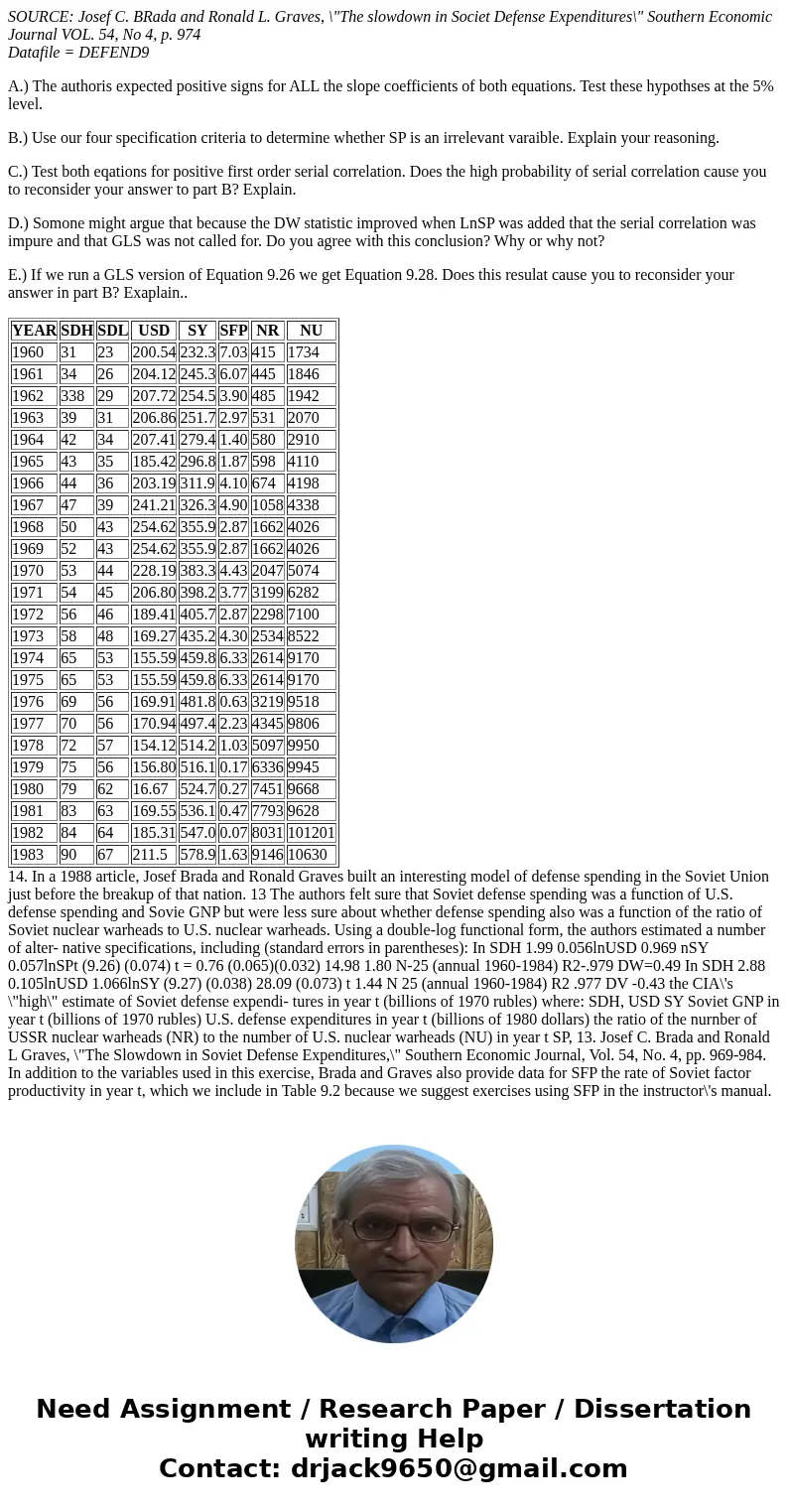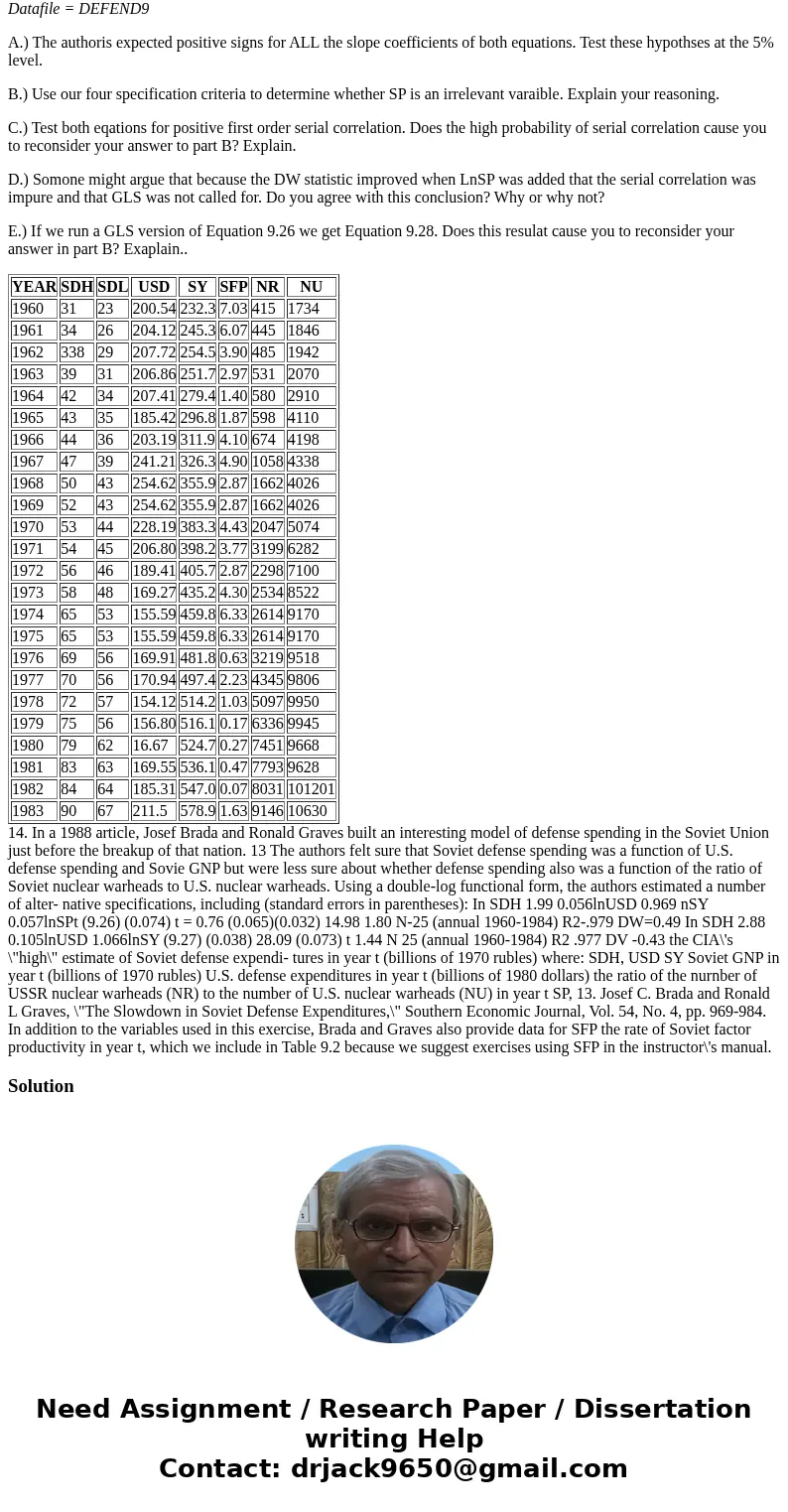SOURCE Josef C BRada and Ronald L Graves The slowdown in Soc
SOURCE: Josef C. BRada and Ronald L. Graves, \"The slowdown in Societ Defense Expenditures\" Southern Economic Journal VOL. 54, No 4, p. 974
Datafile = DEFEND9
A.) The authoris expected positive signs for ALL the slope coefficients of both equations. Test these hypothses at the 5% level.
B.) Use our four specification criteria to determine whether SP is an irrelevant varaible. Explain your reasoning.
C.) Test both eqations for positive first order serial correlation. Does the high probability of serial correlation cause you to reconsider your answer to part B? Explain.
D.) Somone might argue that because the DW statistic improved when LnSP was added that the serial correlation was impure and that GLS was not called for. Do you agree with this conclusion? Why or why not?
E.) If we run a GLS version of Equation 9.26 we get Equation 9.28. Does this resulat cause you to reconsider your answer in part B? Exaplain..
| YEAR | SDH | SDL | USD | SY | SFP | NR | NU |
|---|---|---|---|---|---|---|---|
| 1960 | 31 | 23 | 200.54 | 232.3 | 7.03 | 415 | 1734 |
| 1961 | 34 | 26 | 204.12 | 245.3 | 6.07 | 445 | 1846 |
| 1962 | 338 | 29 | 207.72 | 254.5 | 3.90 | 485 | 1942 |
| 1963 | 39 | 31 | 206.86 | 251.7 | 2.97 | 531 | 2070 |
| 1964 | 42 | 34 | 207.41 | 279.4 | 1.40 | 580 | 2910 |
| 1965 | 43 | 35 | 185.42 | 296.8 | 1.87 | 598 | 4110 |
| 1966 | 44 | 36 | 203.19 | 311.9 | 4.10 | 674 | 4198 |
| 1967 | 47 | 39 | 241.21 | 326.3 | 4.90 | 1058 | 4338 |
| 1968 | 50 | 43 | 254.62 | 355.9 | 2.87 | 1662 | 4026 |
| 1969 | 52 | 43 | 254.62 | 355.9 | 2.87 | 1662 | 4026 |
| 1970 | 53 | 44 | 228.19 | 383.3 | 4.43 | 2047 | 5074 |
| 1971 | 54 | 45 | 206.80 | 398.2 | 3.77 | 3199 | 6282 |
| 1972 | 56 | 46 | 189.41 | 405.7 | 2.87 | 2298 | 7100 |
| 1973 | 58 | 48 | 169.27 | 435.2 | 4.30 | 2534 | 8522 |
| 1974 | 65 | 53 | 155.59 | 459.8 | 6.33 | 2614 | 9170 |
| 1975 | 65 | 53 | 155.59 | 459.8 | 6.33 | 2614 | 9170 |
| 1976 | 69 | 56 | 169.91 | 481.8 | 0.63 | 3219 | 9518 |
| 1977 | 70 | 56 | 170.94 | 497.4 | 2.23 | 4345 | 9806 |
| 1978 | 72 | 57 | 154.12 | 514.2 | 1.03 | 5097 | 9950 |
| 1979 | 75 | 56 | 156.80 | 516.1 | 0.17 | 6336 | 9945 |
| 1980 | 79 | 62 | 16.67 | 524.7 | 0.27 | 7451 | 9668 |
| 1981 | 83 | 63 | 169.55 | 536.1 | 0.47 | 7793 | 9628 |
| 1982 | 84 | 64 | 185.31 | 547.0 | 0.07 | 8031 | 101201 |
| 1983 | 90 | 67 | 211.5 | 578.9 | 1.63 | 9146 | 10630 |
Solution


 Homework Sourse
Homework Sourse